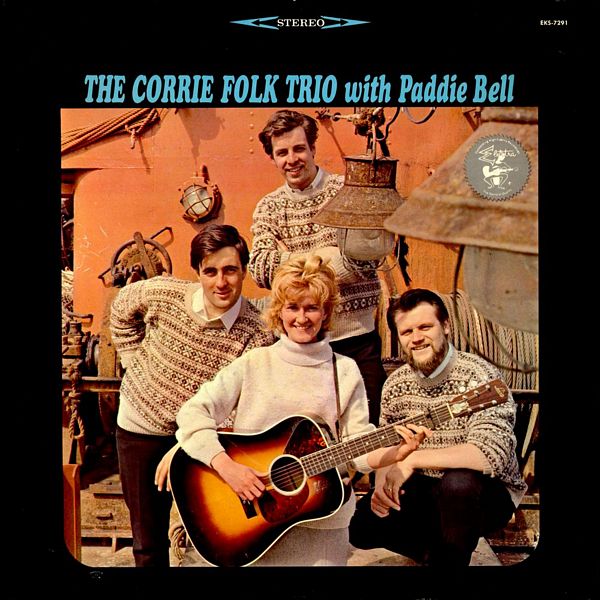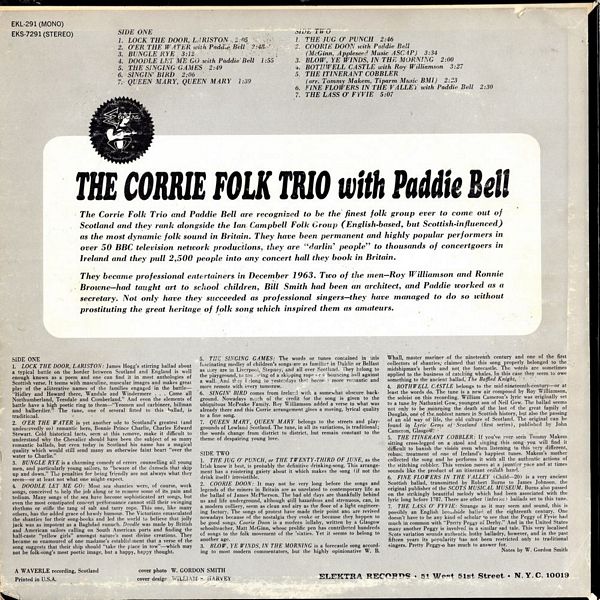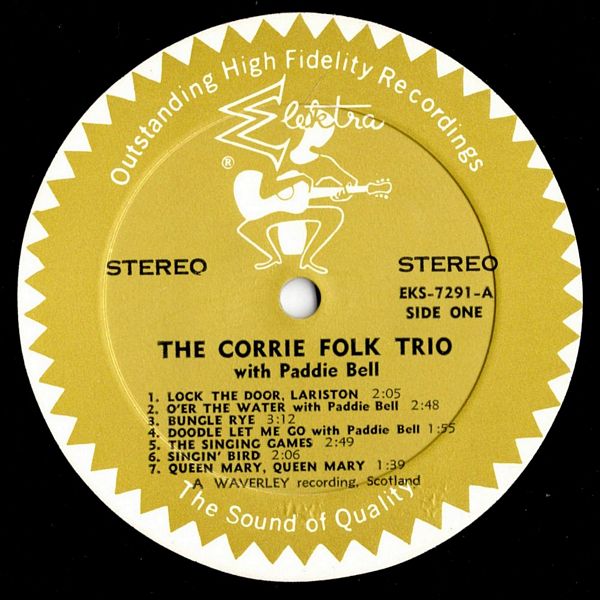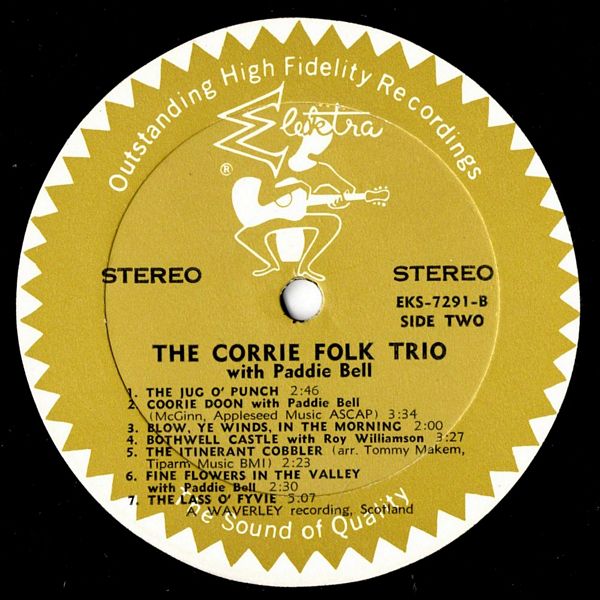

 |


 |
Sleeve Notes
The Corrie Folk Trio and Paddie Bell are recognized to be the finest folk group ever to come out of Scotland and they rank alongside the Ian Campbell Folk Group (English-based, but Scottish-influenced) as the most dynamic folk sound in Britain. They have been permanent and highly popular performers in over 50 BBC television network productions, they are "darlin' people" to thousands of concertgoers in Ireland and they pull 2,500 people into any concert hall they book in Britain.
They became professional entertainers in December 1963. Two of the men — Roy Williamson and Ronnie Browne — had taught art to school children, Bill Smith had been an architect, and Paddie worked as a secretary. Not only have they succeeded as professional singers — they have managed to do so without prostituting the great heritage of folk song which inspired them as amateurs.
LOCK THE DOOR, LARISTON: James Hogg's stirring ballad about a typical battle on the border between Scotland and England is well enough known as a poem and one can find it in most anthologies of Scottish verse. It teems with masculine, muscular images and makes great play of the alliterative names of the families engaged in the battle — "Hidley and Howard there, Wandale and Windermere … Come all Northumberland, Teesdale and Cumberland." And even the elements of battle have a high poetic ring to them — "Yeomen and carbineer, billman and halberdier." The tune, one of several fitted to this ballad, is traditional.
O'ER THE WATER is yet another ode to Scotland's greatest (and undeservedly so) romantic hero, Bonnie Prince Charlie, Charles Edward Stewart. Cold historical facts, seen at this remove, make it difficult to understand why the Chevalier should have been the subject of so many romantic ballads, but even today in Scotland his name has a magical quality which would still send many an otherwise faint heart "over the water to Charlie."
BUNGLE RYE is a charming comedy of errors counselling all young men, and particularly young sailors, to "beware of the damsels that skip up and down." The penalties for being friendly are not always what they seem — or at least not what one might expect.
DOODLE LET ME GO: Most sea shanties were, of course, work songs, conceived to help the job along or to remove some of its pain and tedium. Many songs of the sea have become sophisticated art songs, but even the most constipated concert performance cannot still their swinging rhythms or stifle the tang of salt and tarry rope. This one, like many others, has the added grace of bawdy humour. The Victorians emasculated the shanties for their song-books and led the world to believe that jolly jack was as impotent as a Baghdad eunuch. Doodle was made by British and American sailors calling on South American ports and finding the half-caste "yellow girls" amongst nature's most divine creations. They became so enamoured of one madame's establishment that a verse of the song suggests that their ship should "take the place in tow" — which may not be folk-song's most poetic image, but a happy, happy thought.
THE SINGING GAMES: The words or tunes contained in this fascinating medley of children's songs are as familiar in Dublin or Belfast as they are in Liverpool, Stepney, and all over Scotland. They belong to the playground, to the swing of a skipping rope or a bouncing ball against a wall. And they belong to yesterdays that become more romantic and more remote with every tomorow.
SINGIN' BIRD comes from Ireland with a somewhat obscure background. Nowadays much of the credit for the song is given to the ubiquitous McPeake Family. Roy Williamson added a verse to what was already there and this Corrie arrangement gives a moving, lyrical quality to a fine song.
QUEEN MARY, QUEEN MARY belongs to the streets and playgrounds of Lowland Scotland. The tune, in all its variations, is traditional; the words change from district to district, but remain constant to the theme of despairing young love.
THE JUG O' PUNCH, or THE TWENTY-THIRD OF JUNE, as the Irish know it best, is probably the definitive drinking-song. This arrangement has a roistering gaiety about it which makes the song (if not the drink itself) irresistible.
COORIE DOON: It may not be very long before the songs and legends of the miners in Britain are as unrelated to contemporary life as the ballad of Janies McPherson. The bad old days are thankfully behind us and life underground, although still hazardous and strenuous, can, in a modern colliery, seem as clean and airy as the floor of a light engineering factory. The songs of protest have made their point and are revived nowadays because of the nostalgia they evoke or because they happen to be good songs. Coorie Doon is a modern lullaby, written by a Glasgow schoolteacher. Matt McGinn, whose prolific pen has contributed hundreds of songs to the folk movement of the 'sixties. Yet it seems to belong to another age.
BLOW YE WINDS, IN THE MORNING is a forecastle song according to most modern commentators, but the highly opinionative W. B.
BOTHWELL CASTLE belongs to the mid-nineteenth-century — or at least the words do. The tune is a new air composed by Roy Williamson, the soloist on this recording. William Cameron's lyric was originally set to a tune by Nathaniel Gow, youngest son of Neil Gow. The ballad seems not only to be mourning the death of the last of the great family of Douglas, one of the. noblest names in Scottish history, but also the passing of an old way of life, the old culture of Scotland. The original can be found in Lyric Gems of Scotland (first series), published by John Cameron, Glasgow.
THE ITINERANT COBBLER: If you've ever seen Tommy Makem sitting cross-legged on a stool and singing this song you will find it difficult to banish the vision even when listening to this very different, robust treatment of one of Ireland's happiest tunes. Makem's mother collected the song and he performs it with all the authentic actions of the stitching cobbler. This version moves at a jauntier pace and at times sounds like the product of an itinerant ceilidh band.
FINE FLOWERS IN THE VALLEY (Child — 20) is a very ancient Scottish ballad, transmitted by Robert Burns to James Johnson, the original publisher of the SCOTS MUSICAL MUSEUM. Burns also passed on the strikingly beautiful melody which had been associated with the lyric long before 1787. There are other (inferior) ballads set to this tune.
THE LASS O' FYVIE: Strange as it may seem and sound, this is possibly an English broadside ballad of the eighteenth century. One doesn't have to be any kind of scholar to see that the Peggy of Fyvie had much in common with "Pretty Peggy of Derby." And in the United States many another Peggy is involved in a similar sad tale. This very localised Scots variation sounds authentic bothy balladry, however, and in the past fifteen years its popularity has not been restricted only to traditional singers. Pretty Peggy-o has much to answer for.
Notes by W. Gordon Smith, 1965